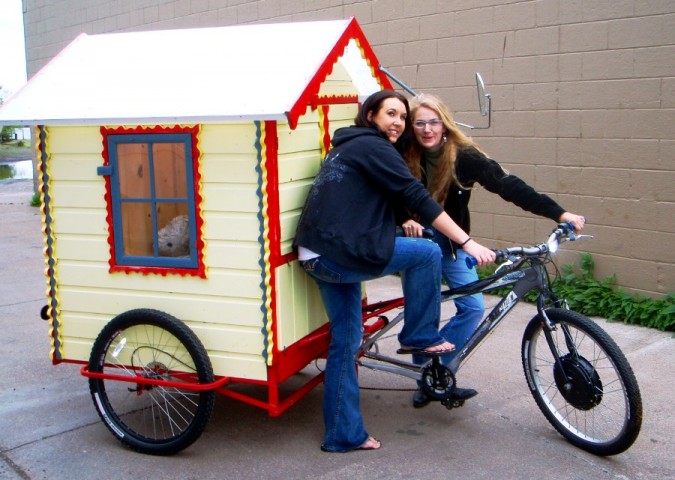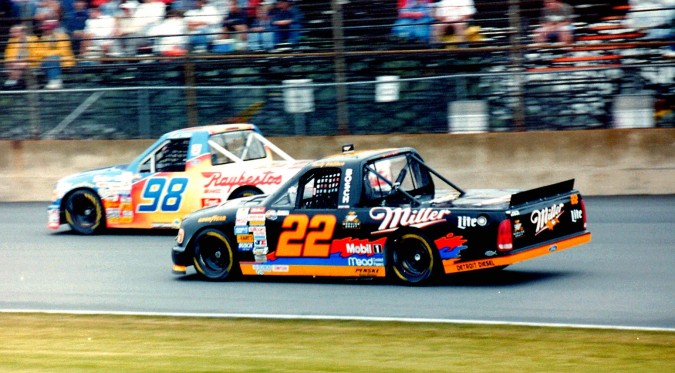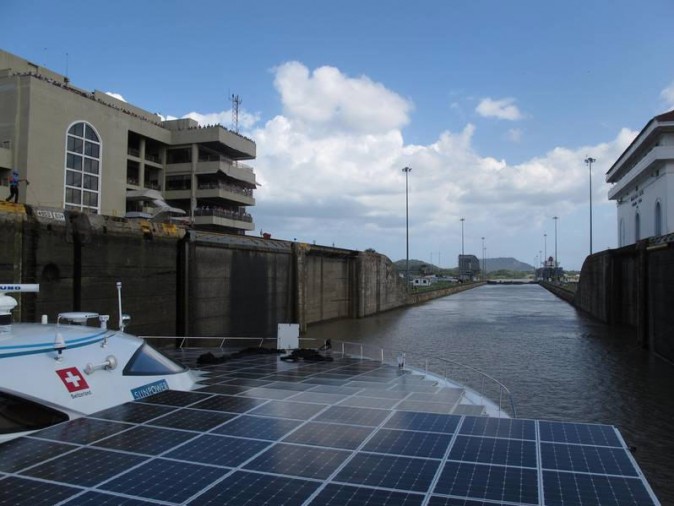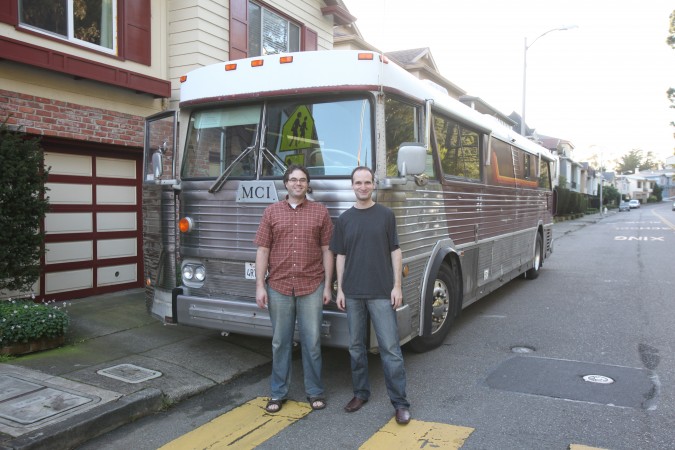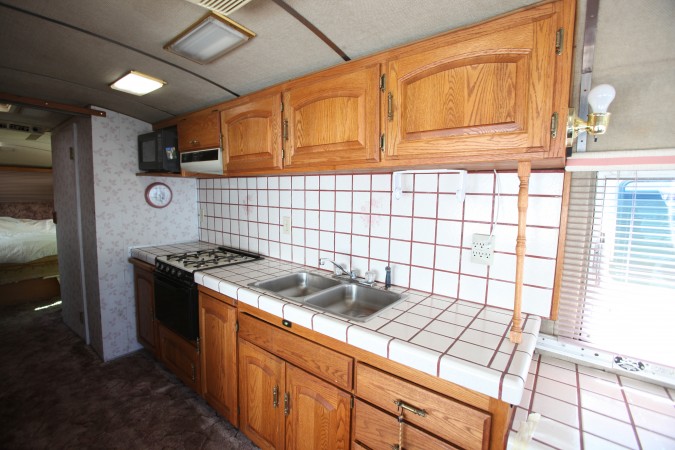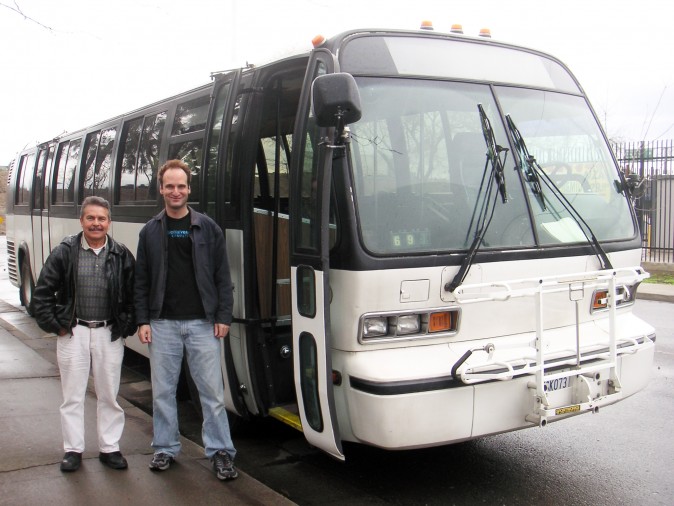Archive for the ‘bus conversions’ tag
Bicycle conversion to bicycle-home
As you know, I’m a big fan of bus conversions, that is, commercial buses that are outfitted with living quarters and retitled as motor homes.
One of the downsides of bus conversions is they consume diesel fuel. Yes, if you travel with a group and avoid hotels, restaurants and convenience stores, they are probably the most efficient form of travel and on the road sustenance.
Here’s a greener solution I discovered today, a ‘bicycle conversion.’ It sure is cute, don’t you think?
It appears to have an electric motor in the front wheel hub, and I presume there are batteries in the house. I’m surprised there aren’t solar panels on the roof to charge the batteries.
This bike was custom built by Superior North Outdoor Center & Bike Shop, of Grand Marais. MN. The house was built by Ken & Molly Hoffman. Here’s a video of Anna Klobuchar briefly riding the bike house, courtesty of the Velomarais bike shop website.
While this looks too small to sleep in, I don’t see why the house couldn’t be lengthened. Yes, it would get heavier, but perhaps more batteries could be included, and perhaps two of the wheels could be motorized. I’ve seen some extremely long two person bikes with solar panels at Maker Faire, bikes that are longer than this house would need to be even if made long enough to sleep in. What a conversation starter this would be for someone to bike across a country in. The rider could blog the entire way, and I suspect he or she could find unlimited front or backyards to camp in free of charge, just by soliciting invitations on their blog. A few choice ads on the outside of the house and bike might even pay for the incidentals required along the way. I love it!
I want to drive my bus conversion around the world to promote green living
Last year I read the book Take your RV to Europe by Adelle and Ron Milavsky. This book was inspiring, for it made me want to take my RTS bus conversion to Europe, and I have been planning this trip now for about a year. Last year I told my entire family about my plans.
The authors of Take your RV to Europe took their Toyota based class C RV to Europe, and now leave it parked there full time so they can fly over and go on extended multi-month voyages as they please without the hassle of shipping the vehicle over for each trip.
I got shipping quotes last year around June of 2010, and the price is about $7,000 each way to take my 40 foot long conversion to The Port of Rotterdam, Netherlands from The Port of Oakland, California, the nearest large ocean shipping port to my house.
My plan has been to spend a solid year traveling and living in the conversion full time. The book makes it clear that Europe is very friendly to recreational vehicles, much more so that is the United States. In most medium and large European cities there are RV parks, unlike in the US. For example, there are large RV parks in London and Paris. The one in Paris is walking distance to a Metro station… just outstanding. There are no RV parks in San Francisco, where I live, one of the most popular tourist destinations in the world… just awful.
Take your RV to Europe makes a strong case that shipping your RV to Europe is the least costly way to travel for an extended time in Europe.
Fuel is costly in Europe, granted, but distances are short compared to the US.
Restaurant food is costly, so being able to cook on board the RV saves a fortune compared to staying in hotels or even youth hostels. I stayed in a couple of different youth hostels in 2009 when I was in Amsterdam, Netherlands, and I recall paying around 40 Euros a night, which really adds up, particularly since you need to buy lunch and dinner on your own. If I were to do an extended tour of Europe, I would hope I had a new girlfriend or wife by then and would be able to bring her along.
While it may be a while before I embark on a European bus conversion adventure, I wanted to share with you my newest variant of my dream, which I am really excited about:
I want to elevate my trip from a mere road trip into a voyage to change the world.
As you know now from my frequent posts about my plans to build many green features into my beloved RTS, I am passionate about living efficiently. While I own a 1,600 square foot house in the center of San Francisco, California USA, I don’t use all that space for just myself. I rent out most of it to my 4 roommates. Divided evenly, that comes to 320 square feet per person, which is close to the area inside my bus conversion.
Most of the inhabitants of the world live in dwellings much smaller than the average US house.
There are many great advantages to choosing to live in smaller dwellings — interest savings, maintenance savings, time savings, energy savings and mental energy savings, for example.
My green bus will be loaded with technology that will showcase how green living can still be richly pleasurable and rewarding. Few people have ever stepped foot in a truly green home, in part because few such homes exist. They certainly don’t exist in every city and town in the US and Europe. But my green RTS can visit such towns and cities with relative ease.
I hope to be able to change the world by showing people my green bus and telling them about it. I am already working hard to develop my journalism skills by building up my audience for this blog at KevinWarnock.com. I am not scared to speak in public, and I’ve been interviewed on the radio before, while I was CEO at Hotpaper.com, my first Internet startup from the first dot com boom in the 1990s.
I envision arriving in a new city or town and parking my green bus conversion right in front of the venue I will be speaking at. There, I will spend the night. I will address the group assembled by my host and then invite the group to tour my green home. Since it will be my actual home for an extended period, it will be believable in a way that I think most model futuristic homes are not, because they don’t look lived in, because they are not lived in.
I will get my start on this public speaking circuit in the San Francisco Bay Area, where there are many receptive audiences for my green messages. As I build my blog readership and get speaking credits, I hope to get more radio interviews and then television interviews.
At this point, when my ideas are getting more attention, I hope that I will be able to recruit sponsors to help me pay for my eventual adventure traveling around Europe, which will cost perhaps $50,000 for the year. I have been thinking of getting sponsors for a while now, but I really decided to try to make it actually happen when I read the inspirational stories at PlanetSolar.org, which describes a solar electrically powered yacht circumnavigating the globe right now to help publicize the potential of solar electricity. The owners of the Planet Solar craft got sponsors to help pay for the project, which probably has a cost surpassing $20 million, since the boat alone reportedly cost $17.5 million. I first learned of the PlanetSolar project in National Geographic magazine, which my roommate Marie had on the dining room table last week. Thank you Marie.
I need to make friends with the Planet Solar team, including Patrick Marchesseau, the ship’s master.
My green bus conversion offers many opportunities for sponsorship. With slide out trays, I could probably fit $20,000 of solar panels on the roof, which would be enough to fully air condition the vehicle on a hot sunny day. For a large house, it might take $200,000 of solar panels to do the same, which is just too expensive for most to even consider. But if people could reduce their living space, all kinds of formerly cost prohibitive technologies become affordable. While $20,000 is still a lot of money, over time it’s not much, considering those solar panels will last for a quarter of a century. Electricity will cost a lot more then than now, so after inflation, the $20,000 really won’t seem like much. Right now I only have $1,000 worth of solar panels on the roof, due to budget constraints.
Buses routinely have billboards on their sides, so sponsors could show off their participation in return for their help. Such ads would help me spread the word as well, as they would draw attention to me and help me start conversations wherever I park.
When I downloaded the picture above of the Planet Solar craft navigating through the Panama Canal, I noticed the SunPower logo on the side. My friend Matt Campbell works at SunPower. Maybe he’ll introduce me to their sponsorship group? Are you reading this Matt?
Once I get sponsors, I would probably have to register my RTS as a commercial vehicle and begin paying commercial vehicle insurance rates. As a side note, I insure my RTS with Progressive Insurance, and I recommend this company.
I want to be perfectly clear that currently I accept no sponsorships and am not running any kind of a business with my RTS. Right now it’s my hobby with no business angle whatsoever. It actually costs me a lot, as you might well guess. Commercial insurance is expensive, so I would love to one day get an insurance company as a sponsor, so they could insure it as part of their sponsorship.
Why would an insurance company care? I suspect that solar panel insurance is going to be big business one day, as having tens of thousands of easily re-sellable and highly durable panels just sitting on a roof makes them a target for thieves.
With the right sponsors, I might one day even upgrade the vehicle drivetrain. It is a bit ridiculous to be advocating super green living while driving a vehicle that gets only 11 miles to the gallon on the freeway. It would be much better to use a modern electric drivetrain, from one of the innovative startups working hard on such things, such as Motiv Power Systems, which recently received a 7 figure government grant to develop electric power-trains for shuttle buses. These drivetrains are expensive for non transit system use, but with a sponsor they could be practical. If my green bus conversion were all electric, I could see getting featured on prime time network and cable television shows in every country I visit. I know the founders at Motiv Power Systems, and they are passionate about their dream to electrify transit buses. I’m not sure their drivetrains are suitable for intracity travel.
Once I tour Europe, I can then see touring Asia and the United States. I don’t plan to tour the US first as I’ve already driven across the US in my bus once, and the distances are so great I fear I would spend more time driving than speaking and showing, which I believe are key to changing perceptions about how much space is needed for a happy life. I also believe audiences in Europe and Asia will be more receptive to my ideas since their residents already live in smaller dwellings and pay much more for energy than residents do in the United States.
Profile former pipe bending machine – I want one
I am continuing to work on my RTS bus conversion on weekends and in the evenings.
My current project is designing a sliding window shade that insulates the window when closed. Sadly, the RTS has single pane windows, and double pane windows are not available. For most conversions, one can buy factory new double pane replacement windows from Motion Windows. You send them a tracing of the original windows and they ship you a wooden crate with double pane windows that fit perfectly. That is possible because most buses used for conversions have flat glass in the side windows.
But my RTS was designed by General Motors, and they wanted a curvy modern shape to the vehicle like a car would have. The glass panes are curved, and Motion Windows can’t make a double pane curved pane window.
As a result, I will make sliding window shades that fit in a track lined with wool felt. Passenger airline windows are the closest example of what I envision. When you raise the shade, the shade disappears up into the inside of the ceiling, so that most of the shade is parallel to the roof when raised.
I built a prototype some time back, and the idea worked, but the sliding of the shade was stiff, and it sometimes got stuck and needed to be lowered and raised again in one smooth action. The cause of this was the complete lack of suitable bearings on the shade, which was a piece of unmounted countertop Formica plastic laminate.
My new version uses Delrin ball roller bearings on the sides of a 1/32″ thick sheet of 5052 aluminum, which is bendable such that it can conform to the curve where the wall meets the ceiling.
I envision that the bearings will roll against 3/8″ square aluminum bar on the left and right of the shade, perpendicular to the floor. What’s been troubling me for a long while is how will I form the gentle yet variable radius bend into the aluminum so that I can install it. Today on YouTube I discovered the machine I need. I don’t know if TechShop has one of these, but if they don’t I suspect some machine shop in San Francisco has one and that I could have them bend the 20 pieces I’ll need to complete the shades. It would seem these could all be bent in an hour or three by someone who knows how to use the machine.
It may also be quite practical for me to simply build a wooden bending form that incorporates the varying curves I need, and just bend them with my own arms, as 3/8″ is not that thick. I suspect this is the way I’ll go. However, the machine I found is so impressive I wanted to write a post about it and show you the video.
I will insulate the aluminum shade with Reflectix brand reflective ‘bubble wrap’ style insulation. This insulation looks like bubble wrap sandwiched between two layers of aluminum foil. It’s very flexible, and the foil part is a plastic foil, not real aluminum foil, so it can be bent many times without cracking. Reflectix is also thin, so it will be able to glide up into the ceiling cavity without binding. This tight fitting shade with its Reflectix backing will probably insulate as well as the costly Motion Windows, and I get a built in window shade that should look high tech and sleek. My prototype certainly looked sleek, and I believe the improved aluminum version will be quite handsome. I’ll keep you posted on my progress.
I sold my MCI 5a Challenger bus conversion
I sold my MCI 5a Challenger bus conversion last week! The buyer was a computer programmer like me, and I would guess he’s about the same age I was when I bought the vehicle in 2001. He wants to travel and be able to program on the road, just like I imagined when I bought the MCI.
I received a LOT of interest in my ad, which I posted on Craigslist.org. I got about 45 replies, and I showed the conversion to half a dozen potential buyers. What an interesting array of people came to see it.
The most surprising visit was from a married couple from Woodside, California. Woodside is one of the most exclusive towns in California. The homes run into the millions of dollars each, and the lots run into the acres each. This particular couple live on a 3 acre parcel. They are the last people I would think would be interested in a 45 year old $5,000 bus conversion.
I learned it wasn’t for them, but for their daughter who’s in her 20s. Their daughter wanted my conversion because four of her friends live in buses, and she wants to live in a bus too, but safely nestled on her parent’s property in Woodside. Apparently the property is so large the neighbors wouldn’t be able to see the home on wheels, which is probably a good thing, as I don’t know too many wealthy people who are fond of ancient, unrestored bus conversions.
The couple was plainly appalled that their daughter wanted my bus conversion. But they still spent a good hour in the rain with me looking over every aspect of their daughter’s proposed dream home. The wife told me I was an excellent salesman, and she seemed more charmed with the vehicle than I would have ever expected.
The reason they were there instead of the daughter is the daughter was away in India for a long trip, and wouldn’t return for a month. Her parents were seriously considering buying the beast and having me deliver it and park it on their estate, awaiting the return of their daughter.
I never heard from this couple after the very pleasant hour I spent with them, and I think it was wise for her daughter to not own my bus conversion, as it really is not set up for full time living, since the insulation is not sufficient for that use, in my estimation. I would much prefer that they hire me to build their daughter one of my ‘green homes’ I’ve been talking about here. That would probably give her outstanding bragging rights among her peers, and would be much more suited for full time living.
I got my full asking price of $5,000. I probably could have gotten more, as I had people begging me to accept a deposit to hold it until the bank opened the next business day. I didn’t think that would be fair to the other buyers I had scheduled for visits, so I declined. I do think I set the price fairly, and not too low, since the conversion wasn’t perfect. I do miss my beloved conversion, as I had a lot of good times on board. It’s the only vehicle I’ve driven across the United States, and the only vehicle I’ve called a home. When I was courting my last girlfriend, we took trips to Monterey and Yosemite, and those were some of the happiest days of my life. I hope the new owner builds a similar set of happy memories, and I wish him all the best.
Bus Conversions Magazine
I just wanted to give a plug to Bus Conversions Magazine. This is the magazine that got me hooked on this ridiculous yet fantastic hobby of converting a bus into a motorhome. I read their website daily, and I’ve learned a dramatic amount from the discussion forum the publisher hosts as a public service to subscribers and non-subscribers alike.
I’m sure they would like some more subscribers, as some of their readers had to group together to buy the magazine from the founder a while back to keep it afloat. The quality has gone way up under the new ownership. There used to be glaring typos throughout, but they have been mostly eliminated. I hope to become a columnist for this magazine one day, writing about my super green RTS conversion, now underway. I hope they will let me adapt my blog postings for print to get started!
I discovered the box in the upper right to subscribe to this blog has been broken for some time, so I don’t have as many subscribers as I otherwise would have. If you liked this post, and would like to subscribe, please type in your email address in the little box in the upper right. I won’t write useless nonsense to you, I promise. Thank you.
I registered my new RTS bus conversion today
Today I registered my new RTS bus conversion I bought on EBay from Adolfo Sanchez of Merced, California. Here’s a picture of me with Adolfo by a branch of the California Department of Motor Vehicles, right after I registered the former San Joaquin County transit authority bus as a motorhome.
I am so happy! What an adventure I’m about to embark on…
Recology San Francisco
I drove my new RTS bus conversion to the dump today. Specifically, the Recology dump.
Going to the dump is an experience not to be missed in life.
When you’re driving a bus conversion, you have to use the special scale they normally reserve for garbage trucks. The normal scale is too small for the long wheelbase of a bus conversion. After you exit the scale, it’s confusing where to go, and I made a wrong turn and headed into the huge warehouse space where the City’s refuse trucks dump their loads of garbage. I took the picture above, which is strangely beautiful I think.
That’s an open pit of trash about the size of a football field. There is a lone ski boot resting on that metal frame. And then there are dozens of seagulls having a feast. The smell in this building was interesting.
I just drove through and out and on to the correct building for consumer home trash dropped off by citizens. That building doesn’t smell bad as people don’t typically dump wet food trash.
I was there to discard a few of the bus seats from when my conversion was a commercial transit bus.
These bench seats are heavy stainless steel, and way too big to cut up and put in the regular trash.
